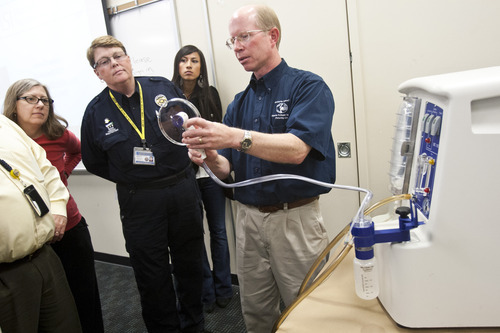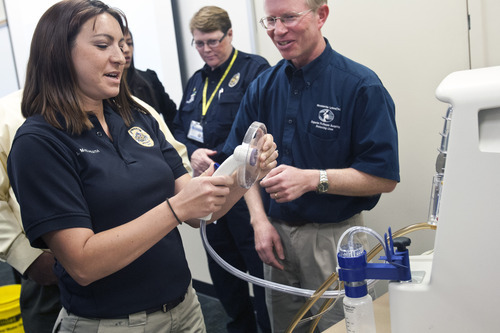This is an archived article that was published on sltrib.com in 2012, and information in the article may be outdated. It is provided only for personal research purposes and may not be reprinted.
The wet vacuum made by Jared Bradley's company was designed to suck bacteria off food — until he described it to his FBI friend, who coveted such a tool for crime scene investigation.
Now Sorenson Forensics, a private DNA-testing lab that aids Utah law enforcement, is using the M-Vac to suck up DNA from crime scene evidence to help close cases. They have already used Microbial-Vac Systems' vacuum — a little blue and white nozzle hooked to a larger machine on wheels that filters and stores the collected evidence — on at least three cases in the state, said Cami Green, sales manager for the lab.
Since those cases have not yet been closed, she declined to specifically identify them. But the vacuum has been used mostly on clothing, and it's helping, Green said.
"This is really big," said Francine Bardole, senior crime scene technician for the West Jordan Police Department. When she heard about the M-Vac, she said her thoughts turned to two recently kidnapped children in Colorado and New Jersey whose backpacks were left at the scenes. Investigators may have been able to pick up the suspect's DNA from the backpacks using the M-Vac, she said.
Jay Henry, director of the Utah State Crime Lab, sees some possibilities in using the M-Vac on old samples after some time has passed, or for collecting the "touch DNA" — genetic material that's left over when someone touches or leaves saliva on a surface. But he was skeptical about using the vacuum on surfaces that many people have likely touched, which he said could produce muddled test results.
"You gotta use the right tool for the right sample," he said.
Alex Koritz, spokesman for the company, said that even in a "crowded" sample, it wouldn't be difficult to separate the DNA and narrow down the suspect.
Crime scene technicians were particularly interested in using it to collect touch DNA. It's nearly invisible and difficult to collect, Bardole said.
But with the M-Vac, it's easier and faster to collect DNA from a broad surface than with tiny swabs, especially within the narrow time frame before the evidence is gone — and it collects a lot more, she said.
The vacuum picks up 40 percent more DNA from a saliva stain on polyester than a cotton swab does, and 88 percent more from a blood stain on nylon fabric, according to the company.
Bradley demonstrated the M-Vac to a room full of officers, medical examiners, attorneys and crime scene technicians at Bardole's police department Wednesday. Draper Police Detective Alyssa McElreath was among those who ran the vacuum on the porous surfaces it's designed to be used on, including a T-shirt, baseball cap and a stone.
It's more difficult for the vacuum to pick up DNA from a rough surface, such as a brick, said Wayne Carlson, the company's vice president of engineering. But that's also true of a swab, he added.
Still, McElreath said she's "ecstatic" about the vacuum. There are cold cases in her department that she would like to revisit with the vacuum, though she declined to name them.
Henry agreed the M-Vac could be another tool in a crime scene technician's rapidly expanding arsenal, but said "it doesn't remove the obligation of the investigator to think."


![Chris Detrick | The Salt Lake Tribune
Microbial-Vac Systems VP of Engineering and Operations Wayne Carlsen demonstrates how to use the M-Vac System at the West Jordan Police Department Wednesday October 24, 2012. ]](https://archive.sltrib.com/images/2012/1025/dnavacuum_102512~0.jpg)






